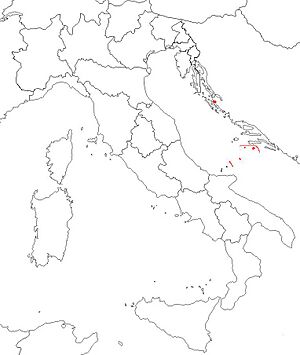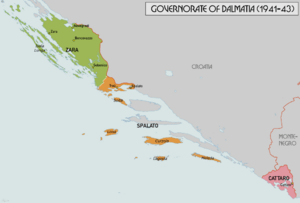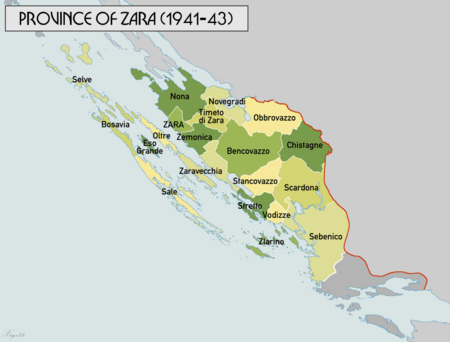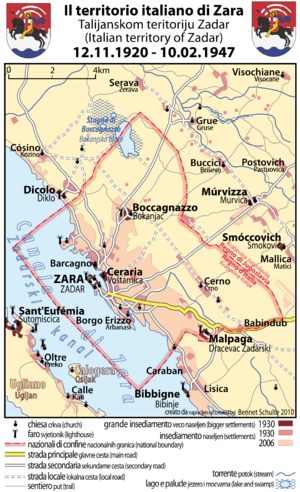Province of Zara facts for kids
Quick facts for kids Provincia di Zara |
|
|---|---|
| Province of the Kingdom of Italy | |
| 1920–1947 | |
 The province of Zara in 1936 |
|
| Capital | Zara |
| • Type | Constitutional monarchy |
| History | |
|
• Italian conquest
|
4 November 1918 |
|
• Treaty of Rapallo
|
12 November 1920 |
| 10 February 1947 | |
The Province of Zara (which means Provincia di Zara in Italian) was a special area that belonged to the Kingdom of Italy. It existed officially from 1918 to 1947. During World War II, in 1941, this province became much larger. It was then made part of a bigger Italian-controlled area called the Governorate of Dalmatia, until 1943.
Contents
How the Province of Zara Began
In 1915, Italy joined World War I. This was because of a secret agreement called the Treaty of London. This treaty promised Italy land from Austria-Hungary if they won the war. This land included parts of northern Dalmatia, like the city of Zara and many Dalmatian islands.
After the war ended, Italian soldiers moved into Dalmatia. They took control of Zara. A famous Italian admiral named Enrico Millo was even called the "Governor of Dalmatia." A well-known Italian writer and nationalist, Gabriele d'Annunzio, also supported Italy taking over Dalmatia. He even sailed to Zara on an Italian warship in December 1918.
In 1918, Zara was a very busy place politically. The old country of Austria-Hungary broke apart. This caused old disagreements between different groups in the city to start again. When the Royal Italian Army arrived in Zara on November 4, 1918, the Italian people in the city, who were the majority, slowly took charge. By December 5, they were fully in control.
The Treaty of Versailles in 1919 changed some of Italy's claims on Dalmatia. However, new agreements were made between Italy and the Kingdom of Serbs, Croats, and Slovenes (which later became Kingdom of Yugoslavia). These agreements, called the Treaty of Rapallo in 1920, gave Zara and some small areas around it to Italy.
The Zara area was like a small Italian island of land. It was about 104 square kilometers (40 square miles) in total. This area included the city of Zara itself. It also had nearby towns like Boccagnazzo/Bokanjac and Borgo Erizzo/Arbanasi. Plus, it included the islands of Lagosta and Pelagosa. This small territory was then set up as an Italian province.
Zara During World War II
In April 1941, Fascist Italy and its allies invaded the Kingdom of Yugoslavia. Zara was an important starting point for this invasion. About 9,000 Italian soldiers were stationed there. These soldiers, led by General Vittorio Ambrosio, easily defeated the Yugoslav army. They quickly reached other cities like Sebenico and Spalato (today known as Split).
Before the invasion, many civilians from Zara were moved to safe cities in Italy. Within a few weeks, Italy's leader, Benito Mussolini, demanded that a new puppet-state, the Independent State of Croatia, give most of Dalmatia to Italy. This included Spalato/Split. Zara then became the main city of a new Italian area called the Governorate of Dalmatia. This new area included the enlarged Province of Zara and two new provinces.
Under Italian Fascist rule, the Slavic people living there faced a policy called "forced Italianization." This meant they were pressured to become more Italian. Many new public projects were built, like hospitals and sewage systems. By 1942, the Province of Zara had about 211,900 people and covered 3,179 square kilometers (1,227 square miles).

In July 1943, Mussolini was removed from power and arrested. The new Italian government signed an agreement with the Allies in September 1943. This meant Italy was no longer fighting against the Allies. However, just a few days later, Mussolini was rescued by German soldiers. He then set up a new government in northern Italy that was controlled by Nazi Germany.
The Independent State of Croatia then said that the agreements giving Dalmatia to Italy were no longer valid. They tried to take over Dalmatia with German help. German soldiers entered Zara first. On September 10, 1943, the German 114th Jäger Division took control of the city.
Zara was not allowed to join the Independent State of Croatia. This was because Zara itself was not part of the agreements that were now being canceled. So, Zara remained under the control of Mussolini's new Italian government. During this time, Zara was heavily bombed by the Allies. Many civilians died, and many old buildings and artworks were destroyed. A large number of people left the city.
By late October 1944, the German army and most Italian officials left Zara. On October 31, 1944, Yugoslav Partisans (resistance fighters) took over the city. At the start of World War II, Zara had about 24,000 people, mostly Italian. By the end of 1944, only 6,000 people remained. The city officially remained Italian until September 15, 1947, when the Paris Peace Treaty was signed.
After World War II, many Italians left Zara. This movement of people is known as the Italian exodus. In a few years, almost all Italians had left the city. In October 1953, the last Italian schools in Zara were closed. Students were forced to attend Yugoslavian schools. This marked the end of the strong Italian identity in the city. Today, only a few hundred Italians live in Zara.
Towns and Villages

Before World War II, the Province of Zara only had a few small towns. These included Boccagnazzo/Bokanjac and Borgo Erizzo/Arbanasi. But when the province became much larger in 1941, the number of towns and villages grew to 20. Here are some of them, with their Italian names first (which were official then) and then their current Croatian names:
- Bencovazzo / Benkovac: About 2,000 people.
- Bosavia or Bosava / Božava: About 1,520 people (including nearby villages).
- Chistagne / Kistanje: About 2,000 people.
- Eso Grande / Iž Veliki (Iž Veli): About 1,300 people.
- Nona / Nin: About 4,650 people (including many small areas).
- Novegradi / Novigrad: About 5,217 people (including Castel Venier and Possedaria).
- Obbrovazzo / Obrovac: About 1,400 people (including Ortopula).
- Oltre / Preko: About 7,560 people (including many islands and villages).
- Sale / Sali: About 2,090 people (including S. Stefano and Sman).
- Scardona / Skradin: About 2,000 people.
- Sebenico / Šibenik: About 37,854 people (including Castell'Andreise and Zablacchie).
- Selve / Silba: About 4,229 people (including Isto, Melada, Premuda, and Ulbo).
- Stancovazzo / Stankovići: About 1,000 people.
- Stretto / Tijesno: About 7,190 people (including Bettina, Gessera, Morter, and Slosella).
- Timeto di Zara / Smilčić: About 1,000 people.
- Vodizze / Vodice: About 7,500 people (including Crappano, Provicchio, and Zatton).
- Zara / Zadar: About 25,000 people.
- Zaravecchia / Biograd: About 2,520 people.
- Zemonico / Zemunik Donji: About 1,000 people.
- Zlarino / Zlarin: About 3,550 people (including Capri and Zuri).
The island-town of Lagosta/Lastovo was later moved to the Province of Spalato.
See also
 In Spanish: Provincia de Zara para niños
In Spanish: Provincia de Zara para niños
- Governorate of Dalmatia
- History of Dalmatia
- Dalmatian Italians
- Bombing of Zadar in World War II
Images for kids





